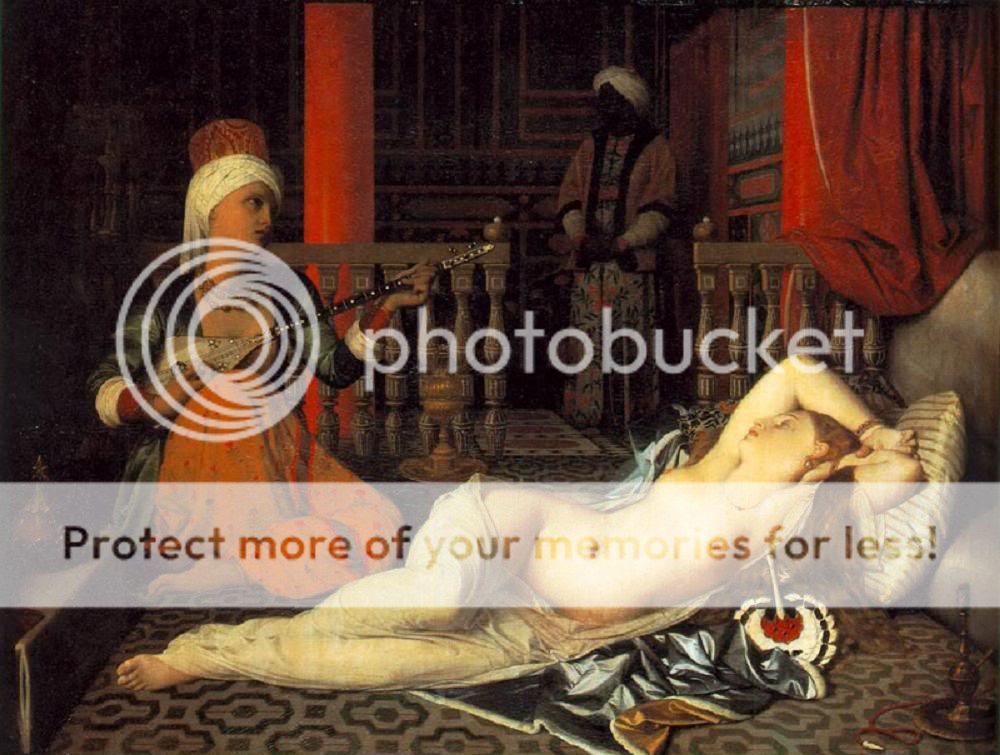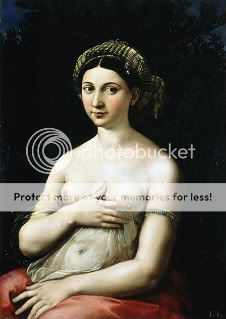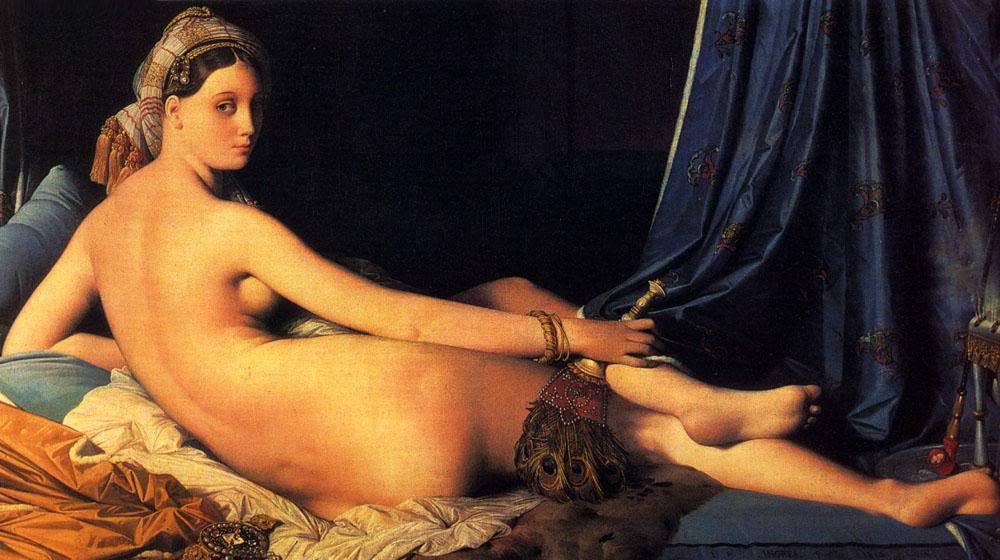Art Sunday 03/16/08: Jean Auguste Ingres
The Grande Odalisque, 1814
Jean Auguste Ingres
The Louvre,Paris,France
Oil on canvas
Ingres, Jean-Auguste-Dominique (1780-1867), French painter, transposed the theme of the mythological nude, whose long tradition went back to the Renaissance, to an imaginary Orient. This work, his most famous nude, was commissioned by Caroline Murat, Napoleon’s sister and the queen of Naples. Here, Ingres painted a nude with long, sinuous lines bearing little resemblance to anatomical reality, but rendered the details and texture of the fabrics with sharp precision. This work drew fierce criticism when it was displayed at the Salon of 1819.
The painting’s title, which means “harem woman,” and the accessories around her conjure up the sensuous Orient. But the woman is also discreet because she shows only her back and part of one breast. The nude was a major theme in Western art, but since the Renaissance figures portrayed in that way had been drawn from mythology; here Ingres transposed the theme to a distant land. The subject of the odalisque fascinated Boucher in the eighteenth century and was later chosen as a theme by Théodore Chassériau (1819-1856), one of Ingres’s pupils. Throughout his career, many of Ingres’s works feature Orientalist themes, such as The Turkish Bath (Louvre), which he painted towards the end of his life. The female nude, historical scenes, and the portrait were Ingres’s favorite genres.

The Grande Odalisque, closeup of the head

Odalisque With a Slave, 1837 Jean Auguste Ingres Oil on canvas
An odalisque (Turkish: Odalık ) was a virgin female slave who could rise in status to be a concubine or a wife in Ottoman Seraglios. Most were part of the harem of the Turkish sultan.
The word appears in a French form, and originates from the Turkish odalık, meaning “chambermaid”, from oda, “chamber” or “room”. Some writers spell the word as, odahlic, odalisk, and odaliq.
An odalisque was not a concubine of the harem, but it was possible that she could become one. Odalisques were ranked at the bottom of the social stratification of a harem, serving not the sultan, but rather, his concubines and wives as personal chambermaids. Odalisques were usually slaves given as gifts to the sultan, although some Georgian and Caucasian families urged their daughters to enter a harem as an odalisque, hoping that they might become a palace concubine, favored slave, or wife of the sultan.
Generally, an odalisque was never seen by the sultan, but instead remained under the direct supervision of the Valide sultan. If an odalisque was of extraordinary beauty or had exceptional talents in dancing or singing, she would be trained as a possible concubine. If selected, an odalisque trained as a concubine would serve the sultan sexually, and only after such sexual contact would she change in status, becoming thenceforth a concubine. In the Ottoman Empire, concubines encountered the sultan only once—unless she was especially skilled in dance, singing, or the sexual arts, and thus gained his attention. If a concubine’s contact with the sultan resulted in the birth of a son, she would become one of his wives.
 The Valpincon Bather, 1808 Jean Auguste Ingres The Louvre, Paris, France Oil on canvas
The Valpincon Bather, 1808 Jean Auguste Ingres The Louvre, Paris, France Oil on canvas
 Paolo and Francesca, 1819 Jean Auguste Ingres Oil on canvas
Paolo and Francesca, 1819 Jean Auguste Ingres Oil on canvas

Raphael and the Fornarina, 1814 Jean Auguste Ingres Oil on canvas
La Fornarina by Raphael Sanzio, 1520

The rumor that La Fornarina (left) is a portrait of Raphael’s mistress began in the Renaissance, but it wasn’t until the 19th century that the story really captured the popular imagination.
Ingres’ imaginary double portrait (above), Raphael and La Fornarina (1814), which shows the dark-eyed lady perched on the artist’s lap, helped turn Raphael’s painting into a cult icon.
The scenario also caught Picasso’s interest; in 1968 he made a series of drawings of Raphael and his lover caught in flagrante by the pope, sometimes with Raphael’s rival, Michelangelo, peeking out from under the bed.
So, is this romantic story fact or fiction? The experts are divided. When La Fornarina was shown in a special exhibition in Rome in 2000, the curators presented X-rays of the painting, which reveal a quickly executed underdrawing, most likely done from life.
Since nude models were hard to come by in 16th century Italy, they argued, Raphael must have been on very intimate terms with the sitter, so they conclude that La Fornarina was Raphael’s lover, Margherita Luti.
|
starfishred wrote on Mar 15, ’08
I ALWAYS LOVE INGRES HE WAS SO GOOD SO SENSUAL THANK YOU FOR THE TOUR.
|
|
lauritasita wrote on Mar 15, ’08
I thought the last painting was the most interesting, LOL!!!
|
|
lauritasita wrote on Mar 15, ’08
WOW dagt !!! It must be so breathtaking to see this art in person !!! Thanks for sharing this ! xoxoxoxxo ~ Laurita
|
|
philsgal7759 wrote on Mar 15, ’08
Very nice
|
|
sanssouciblogs wrote on Mar 15, ’08
Yup, saw it at the Louvre, too, Beautifu,l beautiful art. Wonderful blog. I love Raphael and the Fornarina, how she looks directly at the viewer while the artist admires his work. She’s got nothing to hide
|
|
lauritasita wrote on Mar 15, ’08
That last one is a real attention getter, LOL!!! How often do you see the model sitting on the artist’s lap from that time period ??
|
|
jayaramanms wrote on Mar 15, ’08, edited on Mar 16, ’08
The Art Sunday presentation by you by Jean Auguste Ingres, is as usual great. Jean Auguste Ingres is a great artist and his brushes can bring life into his painting and his works shown here are the evidence for that statement. Yes the last portrait is really beautiful. Thank for selecting such beautiful paintings and sharing with us. Please visit my blog for this art Sunday with the paints of another master painted Guido Reni at –http://jayaramanms.multiply.com/journal/item/88 and comment.
|
|
lauritasita wrote on Mar 15, ’08
Thanks for visiting and commenting, jayaramanms.
|
|
asolotraveler wrote on Mar 16, ’08
even glazed blankish gazes cannot mute the attractiveness of the female form
|
|
wonderful photographs and thanks for sharing. this is such a nice presentation for a person who have never been outside India. thanks for sharing. your encouragement at my site is most welcome! http://shankarg.multiply.com/journal/item/55/2008-m051-Creative_Sunday_it_is_SilkSilkSilk-_15_Mar_13_30_Hrs_Chennai_India
|
|
thanks for inviting jean auguste ingres into your blogs thank you for allowing me participate to exhibit a talented Indian artist through this medium/forum http://rajarishi.multiply.com/journal/item/7/Art_Sunday_-_Raja_Ravi_Varma_Part_I_-_006
|
|
wickedlyinnocent wrote on Mar 16, ’08
Ingres, and his Romantic vision of harem girls, la grande odalisque had a vertebra too many but who cares, she’s still magnificent. Thanks for participating, Laurita, have a wonderful Sunday!
|
|
lauritasita wrote on Mar 16, ’08
I thought the last one was very interesting. That’s a sight you don’t see every day in those times !
|
|
greenwytch wrote on Mar 16, ’08
WOW!
|
|
lauritasita wrote on Mar 16, ’08
That Grand Odalisque is such a masterpiece.
|


Comments
Art Sunday 03/16/08: Jean Auguste Ingres — No Comments
HTML tags allowed in your comment: <a href="" title=""> <abbr title=""> <acronym title=""> <b> <blockquote cite=""> <cite> <code> <del datetime=""> <em> <i> <q cite=""> <s> <strike> <strong>